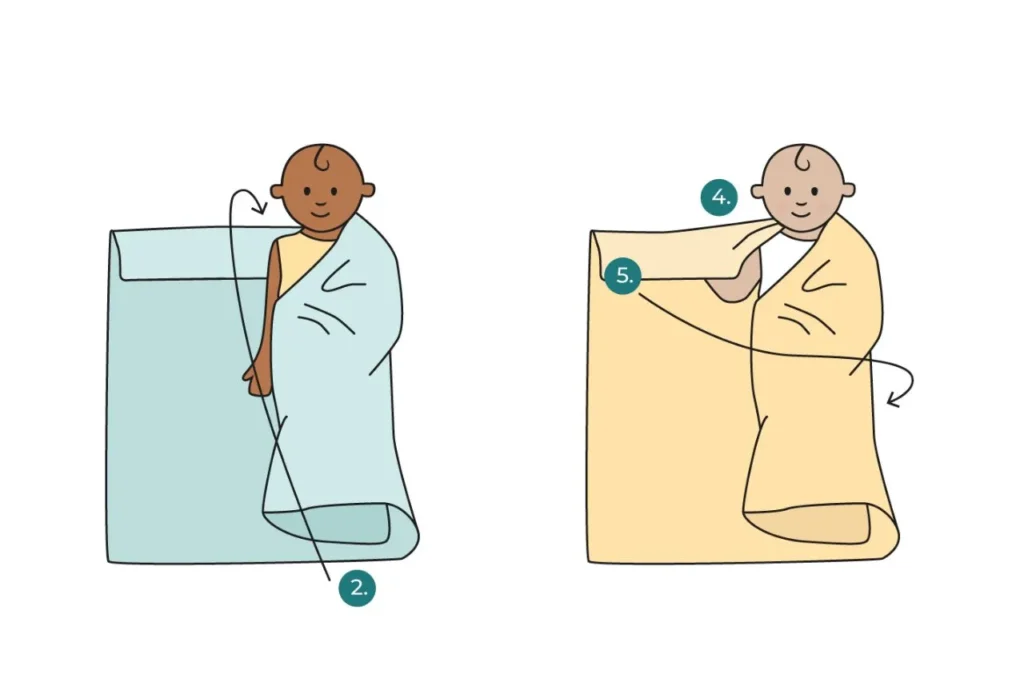Swaddling is an age-old practice that can provide comfort and security to your newborn. It mimics the snug environment of the womb, helping your baby feel safe and calm.
But how exactly do you swaddle a baby?
This guide will provide a comprehensive step-by-step tutorial on how to swaddle your baby. We’ll cover everything from choosing the right swaddle blanket to mastering different swaddling techniques.
Whether you’re a new parent or a caregiver, you’ll find this guide useful. We’ll also address common questions and concerns about swaddling, ensuring you can swaddle your baby safely and effectively.
So, let’s dive in and learn the art of swaddling.
Understanding Swaddling and Its Benefits
Swaddling has been used across cultures for centuries. This simple technique helps newborns transition from the womb to the world. The snug wrap of a swaddle mimics the comfort and security of the womb.
Swaddling offers numerous benefits for infants and parents alike. It helps babies sleep longer and more soundly by suppressing the startle reflex. This reflex can often wake them up unexpectedly.
Another advantage is reduced fussiness. Swaddled babies feel reassured and tend to cry less, which means more peace for everyone. It’s a valuable tool for soothing a restless newborn.
“Swaddling creates the snug, familiar, soothing feeling a baby experienced in the womb before being born,” says Melissa Gersin, RN, a Boston-based maternity nurse and baby-brand product inventor.
Swaddling can also support the development of a healthy sleep routine. Consistent swaddling helps signal bedtime or naptime, creating a comforting pattern. This consistency aids in setting expectations for sleep.
Here’s a quick list of swaddling benefits:
- Promotes longer, restful sleep
- Reduces unnecessary awakenings and fussiness
- Supports bedtime routine development
However, always prioritize safety. Improper swaddling can lead to hip issues or overheating. Always allow room for natural movement.

Choosing the Right Swaddle Blanket
Selecting the right swaddle blanket is crucial for your baby’s comfort. Material and size are key factors to consider. Breathable fabrics like cotton or muslin are ideal.
Cotton blankets are soft and gentle on sensitive skin. They provide warmth without overheating. Muslin, on the other hand, is lightweight and airy, perfect for warm climates.
The blanket’s size is important too. It should be large enough to wrap securely but not excessively bulky. A size of about 44 by 44 inches is commonly recommended.
Consider the fasteners that some blankets offer. Velcro or snaps can simplify the swaddling process, making it quicker and more secure. These features are especially useful for first-time parents.
Aesthetics matter as well. Some parents choose blankets with cute patterns or colors. While looks are secondary, a pleasant appearance can make swaddling more enjoyable.
Preparing to Swaddle: Safety and Comfort
Ensuring your baby’s safety and comfort is paramount when swaddling. Always start on a flat, stable surface. This prevents accidental rolling during the process.
Double-check your baby’s clothing under the swaddle. Lightweight garments work best, preventing your baby from overheating. Too many layers can lead to discomfort.
Always consider your baby’s position. The baby’s neck should remain free without any cloth around it. This helps to reduce the risk of suffocation.
Temperature control is crucial. Your baby’s room should be cool but not cold. Keep the swaddle loose enough for leg movement. This promotes healthy hip development.
Pay attention to your baby’s signs. A fussy or squirming baby may need a looser swaddle. Adjustments can make all the difference in comfort and security.

Step-by-Step Swaddle Instructions
The Diamond Swaddle Technique
Start by laying a blanket on a flat surface in a diamond shape. Fold the top corner down to create a straight edge. Place your baby on the blanket with their neck along the folded edge.
Next, tuck your baby’s right arm gently against their side. Bring the left corner of the blanket across their body and tuck it under the left side. Ensure it’s snug but not too tight.
Then, fold the bottom corner up over their feet. Tuck this part gently under their chin. Lastly, secure by folding the right corner across. This final wrap should hold everything together.

The Square Swaddle Technique
Begin by spreading a square blanket flat. Fold the top edge down to form a straight line. Place your baby centered with their neck at the fold.
Position the left arm at their side. Take the right corner across the baby, tucking it under their left side. Ensure there’s enough room for movement.
Next, draw the bottom corner upwards over their feet. Tuck this over the shoulder for a secure swaddle. Finally, bring the left corner around, securing your baby comfortably.

This method offers a tight, yet flexible fit. It’s ideal for nighttime swaddling.
Alternative Swaddle Methods
Consider alternatives to traditional swaddling. The “arms up” swaddle allows your baby to self-soothe by keeping their hands near their face.
Try the “pod” or “sack” swaddle, which are zippered bags that mimic the womb. These are often quicker and easier, especially during night changes.
Another method is the “kangaroo” swaddle, which keeps arms and legs in a natural position. It’s great for babies who prefer more movement.
Each method offers unique benefits. Experiment to find what calms your baby best.

Baby’s Arm and Leg Positions When Swaddling
The position of your baby’s arms is crucial when swaddling. Some babies prefer arms down for a snug fit. This position helps reduce the startle reflex, allowing your baby to sleep better.
Others may prefer to have one or both arms free. This swaddle variation gives your baby a sense of freedom while still providing warmth and comfort. It’s important to consider your baby’s preference to find the most calming option.
Leg position is equally important in swaddling. Allow room for natural hip movement to promote healthy joint development. The hips should be able to bend and move to avoid hip dysplasia.
Always ensure the swaddle is tight enough to secure but loose enough for movement. This balance is essential for safety and comfort. Regularly check the swaddle to maintain this balance.
How to Swaddle with Different Types of Blankets
Using a Standard Blanket
Swaddling with a standard blanket is versatile and effective. Begin by laying the blanket on a flat surface in a diamond shape. Fold the top corner down, forming a straight edge.
Place your baby on the blanket with their neck on the folded edge. Gently move one arm down and wrap one side of the blanket over it. Tuck it snugly beneath the baby’s opposite side.
Next, fold the bottom corner up over the feet while leaving room to wiggle. Finally, wrap the remaining corner across the body. This should be tight enough to feel secure but not restrictive.
Using a Muslin Blanket
Muslin blankets are soft and breathable, perfect for swaddling. Start by spreading the muslin blanket out in a diamond shape. Fold down the top corner for a headrest.
Lay your baby on their back with their shoulders aligned to the folded edge. Gently bring one arm down and pull the side of the blanket over. Tuck it snugly under your baby’s opposite side.
Fold up the bottom corner over the feet with space to move. Wrap the remaining side across the baby’s body snugly. This method offers comfort while allowing airflow.
Using a Swaddle Sack
Swaddle sacks simplify the swaddling process. First, unfasten the sack completely and lay your baby inside. Ensure their shoulders align with the sack’s shoulder seams.
Place your baby’s arms in the designated arm areas. Most sacks have specific arm flaps that secure easily, keeping arms close to the body. These flaps make adjusting for arms-in or arms-out easy.
Zip or fasten the swaddle sack according to its design. Ensure your baby is snug yet comfortable, with room for hip movement. Swaddle sacks provide ease and ensure consistent swaddle quality.
Ensuring the Perfect Swaddle: Tips and Tricks
Achieving the perfect swaddle can make a big difference. Always use a smooth, flat surface to spread out your swaddle blanket. This ensures even wrapping for better control.
Ensure your baby’s head remains outside the swaddle. This helps maintain proper airflow. Also, never cover their face with the blanket.
Keep the swaddle snug but flexible around the hips. This allows natural movement and helps prevent hip dysplasia. Check that your baby can move their legs within the swaddle.
Lastly, monitor your baby’s temperature while swaddled. Choose lightweight blankets in warm weather, and consider adding a layer in cooler conditions for comfort and safety.
When to Stop Swaddling: Signs and Transitioning
Knowing when to stop swaddling can be tricky. Look for signs such as rolling over. This indicates that it’s time to start the transition.
Another sign is increased activity. If your baby struggles against the swaddle, they may be ready to stop. Increased movement can indicate a desire for more freedom.
Begin by swaddling with one arm out. This can help your baby adjust gradually. It allows them to explore new sleep positions safely.
Eventually, transition to a sleep sack. It offers warmth without restriction and helps ease your baby into the next sleep phase.
Swaddling FAQs: Addressing Common Concerns
Swaddling comes with many questions. Common concerns involve safety and comfort. Here, we answer frequently asked questions.
Can I swaddle my newborn with arms out? Yes, some babies prefer arms out. It provides comfort and allows more freedom.
How tight should the swaddle be? The swaddle should be snug. Ensure it allows hip movement without constricting breathing.
What is the best material for a swaddle? Natural fibers like muslin or cotton are best. They are breathable and soft, reducing the risk of overheating.
When should I stop swaddling? Typically, swaddling should stop once your baby starts rolling over. This usually occurs around three to four months old.
Swaddling FAQs at a glance:
- Swaddle arms in or out based on preference.
- Ensure snugness while allowing hip movement.
- Prefer muslin or cotton for materials.
- Transition when baby starts to roll.
Addressing these concerns can make swaddling a safer, more comfortable experience. Feel confident in your swaddling techniques.
Conclusion and Additional Resources
Swaddling your newborn can transform sleep for both you and your baby. With the right techniques, your baby will feel safe and sound.
Remember to adjust swaddling as your baby grows. Monitor their needs a preferences to ensure comfort at all stages.
If you’re seeking further guidance, numerous online resources and videos can help. Parenting websites often offer detailed tutorials.
For personalized advice, consider speaking with your pediatrician. Their expertise can provide tailored recommendations. With practice, swaddling will become second nature. Enjoy this bonding time with your little one!









